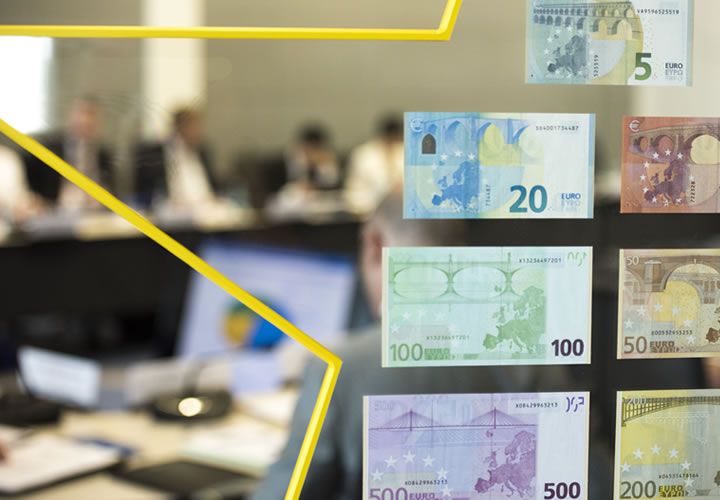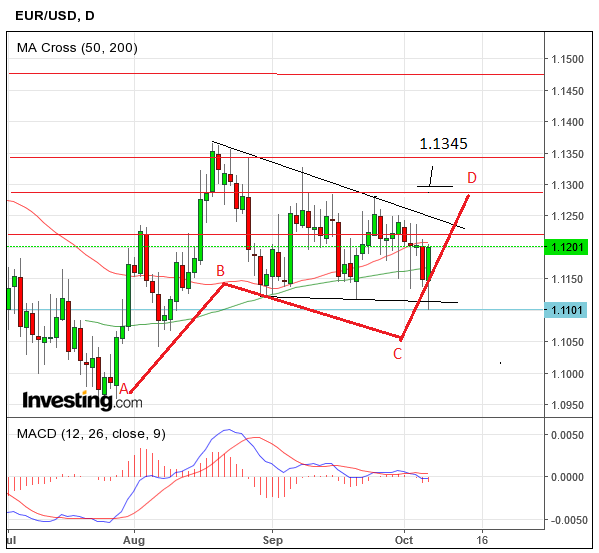Rampant US Dollar has Euro on the Back-Foot, But EUR/USD Losses Could be Limited

The Euro to Dollar exchange rate is looking vulnerable to further losses as the Greenback asserts itself over its fellow G10 currencies.
The US Dollar continues to dominate the G10 complex with gains being recorded not just against perpetual whipping-boy Pound Sterling but also against the usually stubborn Euro.
U"SD is strong again overnight, with AUD and NZD bearing the brunt of the move but all G10 currencies weaker against USD. Diminishing political uncertainty is leading to greater monetary policy certainty," says George Cole at RBC Capital Markets.
The probability of a Fed hike by year-end hit a new four-month high of 75% as the probability of a Trump presidency is at a new low of just 17% (35% in late September) after House Speaker Ryan said he would no longer defend Trump.
At the time of writing EUR/USD is quoted at 1.1114, Friday's close was at 1.1209.
Despite recent losses we note they are not yet of the magnitude required to turn the outlook for EUR/USD notably beairsh.
Although the Euro had the potential break out to the downside last week with a low at 1.1104, it initially stabilised.
"Consequently, we are not seeing a clear directional impetus, with the advantages (quantitative indicators, chart picture) still remaining on the dollar's side. A break below 1.1104 would pretty much see the downtrend accelerate. Supports would then be found at around 1.1050 and around 1.1000," says Ralf Umlauf at Helaba Research in Frankfurt.
Holding out for a Rebound
Our studies suggest the EUR/USD chart is showing a possibility of further upside.
The pull-back from the August highs has formed a consolidation which arguably indicates more upside on the horizon.
The red lines labeled A,B,C and D on the chart suggest a three wave move higher from the July lows, with the current price action constituting the ‘B-C’ part of the pattern:
It also suggests that ‘B-C’ will end soon and evolve into a ‘C-D’ up-wave, which is likely to be roughly equal in length to ‘A-B’.
The three largest moving averages (MA) – the 50, 100 and 200-day MA’s provide strong support to price action at about the 1.1125 level, and each time the exchange rate has moved down it has been unable to break lower.
A breakout to the upside is expected, with a move above the 1.1280 late September highs, confirmed by a move above 1.1300, expected to lead to a target at 1.1345.
However, not everyone is convinced EUR/USD is moving higher with Ralf Umlauf at Helaba in Frankfurt saying the technical picture remains clouded.
"Indicators in the daily chart such as MACD, DMI or Stochastic are in sell mode, with the risk of a renewed downtrend as a result. Below the support at 1.1104, there are supports to be found at 1.1046 and 1.1000. We locate resistances in the vicinity of 1.1280. Our favoured trading range: 1.1100 – 1.1250," says Umlauf.
Euro Weakness to Remain Temporary
The recent Deutsche Bank crisis actually strengthened the single currency rather than weakened it, for several reasons.
The first of these was the fact that the DB crisis lessened the chances of the European Central Bank (ECB) expanding stimulus and pressuring interest rates and the euro with them lower.
This is because lower interest rates take a toll on bank profitability and the last thing the ECB would want to do would be to further endanger the health of its already vulnerable banking sector.
Secondly, the DB crisis reverberated around the globe leading to an immediate sale of risky assets, many of which had been funded by euro-denominated loans (due to the low lending rates set by the ECB in the Eurozone).
This led to a repatriation of euros after the assets were sold, increasing the demand for euros.
Finally, weak Eurozone banks have been blamed for not being able to ‘recycle’ - or lend out - the large current account surplus, leading to net euro inflows and therefore a stronger currency.
For several reasons the outlook still supports the euro.
The dollar, meanwhile, remains heavily dependent on whether or not the Federal Reserve choose to increase interest rates in December.
Friday’s Non-Farm Payrolls – although marginally lower-than-expected -nevertheless kept the door open to the Fed raising rates before the end of the year.
CIBC Economics’ Royce Mendes, said the rise in payrolls was more than what was needed to “outstrip population growth.”
“It might not have lived up to the rebound markets were hoping for, but today’s employment report in the US still showed solid progress.
“In addition to another payroll gain that outstrips what’s needed to cover population growth, other details in the report also showed strength in September.
“Following a soft spot for economic data in August, the limited indicators released thus far for September have been largely positive, keeping the door open for a rate hike later this year.”
Data Ahead for the Euro
In a relatively quiet week, the main release for the Euro is the German ZEW sentiment survey.
The ZEW asks financial professionals for their opinion on the current economic situation and the medium term (6-month) outlook for the German economy.
It is considered a useful and fairly reliable indicator of future activity.
The forecast is for a balance of plus four in favour of a more optimistic assessment of the economy, from the previous 0.5 result.
Data Ahead for the Dollar
A quiet week for the dollar sees the first main release on Wednesday, with the Federal Open Market Committee (FOMC) meeting minutes.
According to commentary from broker TD Securities, “On the back of the upbeat tone of recent data, we expect the minutes to reinforce the near-term hawkish stance of the September meeting with the overwhelming majority laying out the arguments for taking the next step in normalization.”
A speech by Fed Chairwomen Janet Yellen on the same day is also likely to reflect a desire for higher interest rates, in line with recent commentary.
Then on Friday we see the release of Core Retail Sales in September, which is forecast to rise 0.4% from -0.1% in the previous month.
Retail Sales is expected to show a 0.3% increase from -0.3% in August.
Factory Gate prices are also out on Friday with analysts estimating a 0.3% rise in September.











